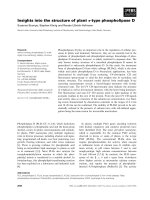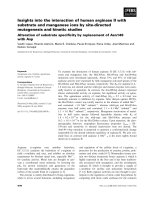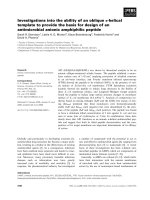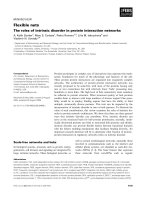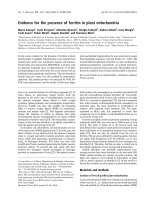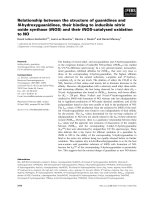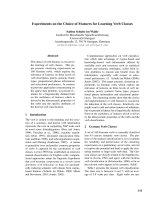Báo cáo khoa học: "Clinical review: The implications of experimental and clinical studies of recruitment maneuvers in acute lung injury" pptx
Bạn đang xem bản rút gọn của tài liệu. Xem và tải ngay bản đầy đủ của tài liệu tại đây (251.45 KB, 7 trang )
115
ALI = acute lung injury; ARDS = acute respiratory distress syndrome; MV = mechanical ventilation; PEEP = positive end-expiratory pressure; RM =
recruitment maneuver; VILI = ventilator-induced lung injury.
Available online />Introduction
Mechanical ventilation (MV) is a supportive and life saving
therapy in patients with acute lung injury (ALI) and/or acute
respiratory distress syndrome (ARDS). Despite advances in
critical care, mortality in these patients remains over 40% [1].
During the past decade the possibility that MV can produce
morphologic and physiologic alterations in the lung has been
recognized [2]. On histopathologic examination, findings in
ventilator-induced lung injury (VILI) do not differ from those in
ARDS [2]. To minimize this damage, lung protective strategies
to avoid overdistension and cyclic collapse and reopening of
alveoli have successfully been used in patients with ARDS
receiving MV [3,4]. Recruitment maneuvers (RMs) consisting
of sustained inflation to open the collapsed alveolar units have
been proposed as an adjunct to MV in anesthesia and ARDS
[5,6]. In most ARDS patients, however, lung recruitment and
overdistension occur simultaneously at higher intrathoracic
pressure [7]. Whether RMs can initiate cellular mechanisms of
injury in healthy parts of the lung is unknown.
In the present review of the literature we describe the intrinsic
mechanisms that explain how MV inflicts alveolar damage and
the controversy regarding the use of RMs as an adjunct to MV.
Finally, we discuss the interactions between lung infection and
periodic application of high intrathoracic pressure, both in
experimental models of ALI and in patients with ARDS.
Method
To identify the most relevant English language publications,
the Medline database was searched using the following
keywords: mechanotransduction, acute lung injury, acute
respiratory distress syndrome, mechanical ventilation, ventilator-
induced lung injury, overdistension, recruitment maneuvers,
and bacterial translocation.
Review
Clinical review: The implications of experimental and clinical
studies of recruitment maneuvers in acute lung injury
Enrique Piacentini
1
, Ana Villagrá
2
, Josefina López-Aguilar
3
and Lluis Blanch
4
1
Research Fellow, Critical Care Centre, Hospital de Sabadell, Institut Universitari Parc Taulí, Universitat Autònoma de Barcelona, Sabadell, Spain
2
Research Fellow, Critical Care Centre, Hospital de Sabadell, Institut Universitari Parc Taulí, Universitat Autònoma de Barcelona, Sabadell, Spain
3
Researcher, Critical Care Centre, Hospital de Sabadell, Institut Universitari Parc Taulí, Universitat Autònoma de Barcelona, Sabadell, Spain
4
Executive Director, Critical Care Centre, Hospital de Sabadell, Institut Universitari Parc Taulí, Universitat Autònoma de Barcelona, Sabadell, Spain
Correspondence: Lluis Blanch,
Published online: 5 September 2003 Critical Care 2004, 8:115-121 (DOI 10.1186/cc2364)
This article is online at />© 2004 BioMed Central Ltd (Print ISSN 1364-8535; Online ISSN 1466-609X)
Abstract
Mechanical ventilation can cause and perpetuate lung injury if alveolar overdistension, cyclic collapse,
and reopening of alveolar units occur. The use of low tidal volume and limited airway pressure has
improved survival in patients with acute lung injury or acute respiratory distress syndrome. The use of
recruitment maneuvers has been proposed as an adjunct to mechanical ventilation to re-expand
collapsed lung tissue. Many investigators have studied the benefits of recruitment maneuvers in healthy
anesthetized patients and in patients ventilated with low positive end-expiratory pressure. However, it is
unclear whether recruitment maneuvers are useful when patients with acute lung injury or acute
respiratory distress syndrome are ventilated with high positive end-expiratory pressure, and in the
presence of lung fibrosis or a stiff chest wall. Moreover, it is unclear whether the use of high airway
pressures during recruitment maneuvers can cause bacterial translocation. This article reviews the
intrinsic mechanisms of mechanical stress, the controversy regarding clinical use of recruitment
maneuvers, and the interactions between lung infection and application of high intrathoracic pressures.
Keywords acute lung injury, lung collapse, lung infection, mechanical stress, mechanical ventilation
116
Critical Care April 2004 Vol 8 No 2 Piacentini et al.
Many different methods of RM delivery have been proposed
in the literature (Table 1). Several investigators have demon-
strated that RMs can increase oxygenation and lung volume
in collapsed prone lungs. However, the benefits of RMs in
terms of oxygenation and lung recruitment in ARDS patients
and in experimental models with alveolar flooding or consoli-
dation are unclear.
Intrinsic mechanism of ventilator-induced
lung injury
The mechanical stresses produced by MV at high pressure or
volumes, and the forces generated by repeated opening and
collapse lead to upregulation of an inflammatory response,
with release of cytokines and chemokines and activation of
neutrophils and macrophages that produce lung damage [2].
Injurious MV can lead to end-organ dysfunction, and the
inflammatory cascade also plays a pivotal role in the systemic
inflammatory response syndrome and in multiple organ
system failure [8–10]. Like all adherent cells, alveolar epithe-
lial cells interact with extracellular matrix through transmem-
brane adhesion receptors such as integrins. These receptors
transmit forces from the surrounding matrix to the cytoskele-
ton via the focal adhesion complex [11]. When the basement
membrane is strained, adherent epithelial cells must change
shape and the ratio of their surface (plasma membrane) to
their volume must increase. If the plasma membrane is dis-
rupted the intracellular lipid stores are utilized to repair the
cell surface. Most breaks are repaired within seconds, usually
via a calcium-dependent response [12]. This dynamic remod-
eling process is the most important determinant of cell
wounding [13].
Mechanotransduction is the conversion of mechanical stimuli,
such as cell deformation, into biochemical and biomolecular
alterations. How mechanical forces can be sensed by cells
and converted into intracellular signals is still unclear, but in
various experiments it was observed that mechanical stimuli
activate the nuclear factor-κB – a critical transcription factor
that is required for maximal expression of many cytokines
involved in the pathogenesis of VILI [14]. It is unknown
whether a single stimulus such as RMs applied during MV
can trigger the above-mentioned pathways of lung injury, and
the long-term benefits and safety of RMs will depend on the
extent of this effect.
Experimental evidence on recruitment
maneuvers
In saline lavaged rabbit lungs, Bond and coworkers [15]
found an improvement in respiratory system compliance and
oxygenation during high frequency oscillatory ventilation after
RMs. In a similar model, Rimensberger and coworkers [16]
showed that a single RM resulted in better oxygenation
without augmenting histologic injury at positive end-expira-
tory pressure (PEEP) below the lower inflection point of the
respiratory system pressure–volume curve, as compared
with the group with PEEP set above the lower inflection
point without RM. Furthermore, those investigators showed
that a single sustained inflation to 30 cmH
2
O boosted the
ventilatory cycle onto the deflation limb of the
pressure–volume curve (Fig. 1). In other words, a RM applied
in a recruitable lung increases the amount of recruited tissue
at end expiration, favoring tidal ventilation.
Table 1
Description of the different methods used in experimental and human studies to perform recruitment maneuvers
Methods Study References
Continuous positive airway pressure at 30–60 cmH
2
O for 15–60 s Saline lavage, oleic acid, and pneumonia in animals [15–20,54]
Pressure controlled mode: peak inspiratory pressure at 60 cmH
2
O and Saline lavage in animals [18,20]
end-expiratory pressure at 40 cmH
2
O for 2 min
Volume controlled mode: 20 breaths at tidal volume of 20ml/kg Anesthetized healthy animals [21]
Continuous positive airway pressure at 30–45 cmH
2
O for 15–20 s Anesthetized healthy patients [23,26]
Pressure controlled mode: peak inspiratory pressure at 30–40 cmH
2
O and Anesthetized healthy patients [24,25,27]
end-expiratory pressure at 10–20 cmH
2
O for 1 min
Sighs with a tidal volume to reach 45 cmH
2
O plateau pressure ARDS patients [29,40]
Continuous positive airway pressure at 30–45 cmH
2
O for 4–40 s ALI/ARDS patients [30,32,38,39]
Extended sigh with a tidal volume to reach 40 cmH
2
O and end-expiratory ARDS patients [31]
pressure at 35 cmH
2
O for 1 min
Pressure controlled mode: peak inspiratory pressure at 40–60 cmH
2
O and ARDS/brain injury patients [33,36,37]
end-expiratory pressure at 10–30 cmH
2
O for 30–120 s
Pressure support mode: peak inspiratory pressure at 40 cmH
2
O and ALI/ARDS patients [35]
end-expiratory pressure for 30 s
ALI, acute lung injury; ARDS, acute respiratory distress syndrome.
117
Some data suggest that RMs have different effects depend-
ing on the type of lung insult and on the use of various combi-
nations of tidal volume and PEEP. Whether RMs are
necessary to prevent alveolar collapse when optimal PEEP is
used remains controversial. Van der Kloot and colleagues
[17] studied the effects of RMs on gas exchange and lung
volumes in three experimental models of ALI: saline lavage,
oleic acid, and pneumonia. After application of RMs, oxygena-
tion improved only in the surfactant depletion group when low
PEEP was used. At high PEEP in any model, RMs had no
effect. Similar effects were observed in the study conducted
by Bond and coworkers [15]. Takeuchi and colleagues [18]
highlighted the difficulties in maintaining tidal ventilation at
high lung volumes. Those investigators showed that, after
RMs, PEEP set at 2 cmH
2
O above the lower inflection point
was more effective in maintaining gas exchange and minimiz-
ing inflammation and lung injury than was PEEP set at the
maximum curvature of the deflation pressure–volume curve.
When recruitment is achieved with posture, Cakar and
coworkers [19] showed better oxygenation after RMs in the
prone than in the supine position, and importantly the benefit
was sustained at lower PEEP. In other studies other adjuncts
to MV were necessary to keep the lung open after RMs [20].
Lu and coworkers [21] demonstrated that RMs completely
reversed the atelectasis, bronchoconstriction, and decrease
in arterial oxygen saturation observed after endotracheal suc-
tioning in an anesthetized sheep model.
In summary, the beneficial effects of RMs have been demon-
strated in animal models of alveolar collapse induced by sur-
factant depletion. However, the pathobiology of ARDS is
more complex and includes an altered vascular barrier func-
tion and alveolar flooding or consolidation. Indeed, in animal
models other than that involving surfactant depletion, the
effect of RMs on lung function is less evident.
Role of recruitment maneuvers in
anesthetized patients
Formation of atelectasis and airway closure are mechanisms
of impaired gas exchange in anesthetized patients with
healthy lungs [22]. RMs have successfully been used to
reverse collapsed dependent areas in these patients. Rothen
and coworkers [22] found that a pressure of 40 cmH
2
O main-
tained for 7–8 s entirely re-expanded the collapsed lung
tissue in anesthetized humans, although the net effect on gas
exchange might be rather small if low ventilation/perfusion
areas still coexist at the time of decrease in intrapulmonary
shunt. Long-term effects of RMs in anesthetized patients
depend on gas composition. Re-expanded lung tissue
remained inflated for at least 40 min at low oxygen concentra-
tion [5], whereas lung collapse reappears within minutes with
pure oxygen [23]. Finally, RMs followed by moderate PEEP
may produce physiologic benefits in patients undergoing
upper abdominal, thoracic, or laparoscopic surgery [24,25],
and in patients prone to develop a moderate degree of lung
injury after surgical procedures [26,27].
Recruitment maneuvers in patients with
acute respiratory distress syndrome
Since the publication of the reports from Amato and cowork-
ers [3] and the Consensus Conference on ARDS [28], the
application of periodic RMs in patients with ARDS has
gained acceptance among clinicians, although controversy
remains. Among the earliest reports providing evidence that
RMs improve lung function was that from Pelosi and cowork-
ers [29], who demonstrated that sighs at 45 cmH
2
O plateau
pressure in patients ventilated with PEEP at 14 ± 2.2 cmH
2
O
significantly improved oxygenation, intrapulmonary shunt, and
lung mechanics. Foti and colleagues [6] observed that RMs
were effective in improving oxygenation and alveolar recruit-
ment only during MV at low PEEP, suggesting that high PEEP
better stabilized alveoli and prevented loss of lung volume. In
the same line, Lapinsky and coworkers [30] reported benefi-
cial effects on oxygenation, but this effect was sustained only
if PEEP was increased after RMs. Lim and colleagues [31]
found an improvement in oxygenation that persisted for 1 hour
after an ‘extended sigh’; this effect was partially lost soon
after ventilatory support returned to the baseline PEEP level.
Other studies have shown a modest and variable effect of
RMs on oxygenation when ARDS patients are ventilated with
high PEEP. Richard and coworkers [32] demonstrated
decreased oxygenation when tidal volume was switched from
10 to 6 ml/kg with PEEP set above the lower inflection point
Available online />Figure 1
Dynamic loops during three modes of ventilation inscribed into the
quasistatic pressure–volume curve of the respiratory system of an
animal after lung washes. Loop A: tidal insuflation with a positive end-
expiratory pressure (PEEP) below the lower inflection point before a
sustained inflation. Loop B: tidal insuflation with a PEEP below the
lower inflection point after a sustained inflation. Loop C: PEEP higher
than the lower inflection point after a sustained inflation. Sustained
inflation promoted alveolar recruitment at low PEEP levels (loop B).
Sustained inflation superimposed on high PEEP favored alveolar
overdistension in this model of surfactant depletion (loop C).
Reproduced with permission from Rimensberger and coworkers [16].
80
70
60
50
40
30
20
10
0
Volume (ml)
0 5 10 15 20 25 30 35 40
Pressure (cmH O)
2
A
B
C
118
of the pressure–volume curve. However, increasing PEEP
and RMs prevented alveolar derecruitment, and RMs per-
formed in patients already ventilated with high PEEP had
minimal effects on requirements for oxygenation support.
Similarly, Villagrá and colleagues [33], studying the effect of
RMs superimposed on a lung protective strategy (tidal
volume <8 ml/kg and PEEP 3–4 cmH
2
O higher than the
lower inflection point on the pressure–volume curve), found no
effect on oxygenation regardless of the stage of ARDS, and in
some patients venous admixture increased during RMs (Fig. 2).
This deleterious effect suggested that the RMs increased lung
volume by overdistending the more compliant already-opened
and aerated alveolar units, favoring blood flow redistribution
from overdistended to collapsed lung regions. Furthermore, a
negative correlation was found between recruited lung volume
induced by PEEP before RMs and RM-induced changes in oxy-
genation, suggesting that RMs are less effective when the
lungs have been near optimally recruited by PEEP and tidal
volume. Recently Hubmayr [34] suggested that alveolar flood-
ing is probably the main mechanism of end-expiratory loss of
lung aeration in human ARDS. This may explain, at least in part,
why RMs are less beneficial in patients with ARDS. Neverthe-
less, when sudden lung derecruitment occurs in conditions of
adequate PEEP ventilation, such as the loss in lung volume
produced during secretion aspiration, Maggiore and coworkers
[35] observed that suctioning-induced lung derecruitment can
be prevented by performing RMs.
The cause of ARDS may also influence the response to RMs.
In a majority of trauma patients developing ARDS, Johannig-
man and coworkers [36] found an improvement in oxygena-
tion after RMs in patients receiving MV with low tidal volume
and high PEEP. However, when Bein and colleagues [37]
analyzed the impact of RMs on intracranial pressure and
cerebral metabolism in patients with acute cerebral injury and
respiratory failure, they observed an increase in intracranial
pressure at the end of RMs and a subsequent reduction in
mean arterial pressure resulting in a decrease in cerebral per-
fusion pressure. Both normalized 10 min after RMs. Grasso
and coworkers [38] found that RMs significantly improved
arterial oxygenation and lung volume in patients with early
ARDS without impaired chest wall mechanics (i.e. with large
recruitment potential). Nevertheless, in the group with low
chest wall compliance, RM-induced lung overdistension
reduced blood pressure and cardiac output, making RMs
ineffective and potentially harmful (Fig. 3).
RMs can also be applied during assisted breathing in non-
sedated patients. Patroniti and coworkers [39] applied one
sigh per minute to baseline pressure support ventilation in
patients with early ARDS. They observed a significant
improvement in arterial oxygenation associated with an
increase in end-expiratory lung volume and respiratory system
compliance during the sigh, suggesting that sighs promote
alveolar recruitment. These changes returned to baseline
after the sighs were discontinued.
Other studies emphasize the importance of body posture
(supine or prone) on regional distribution of intrapulmonary
ventilation and perfusion, and the beneficial effects of prone
position in limiting VILI in experimental animals [40]. Lim and
coworkers [31] found that the benefit was significantly
greater when patients were in the supine position as com-
pared with those in the prone position, suggesting that
patients in the prone position have less collapsed lung. These
findings were recently confirmed by Pelosi and colleagues
[41], who demonstrated that adding cyclical sighs during
ventilation in the prone position provided optimal lung recruit-
ment in the early stage of human ARDS.
Finally, two randomized physiologic pilot studies of RMs
superimposed on low tidal volume ventilation and moderate
to high PEEP conducted in approximately 100 patients with
ALI showed no clear benefits in terms of oxygenation [42,43].
Moreover, RMs were potentially harmful because some
patients developed hemodynamic instability, ventilator dysyn-
chrony, and pneumothorax after RM.
In summary, RMs can be useful in improving oxygenation in
patients receiving MV with low PEEP and low tidal volume.
However, in patients with ARDS receiving MV with high
PEEP levels, the beneficial effects of RMs disappear. RMs
may restore lung volume and oxygenation in endotracheal
suctioning-induced lung derecruitment in mechanically venti-
lated patients diagnosed with ALI/ARDS. RMs should be
Critical Care April 2004 Vol 8 No 2 Piacentini et al.
Figure 2
Relationship between recruitment maneuver (RM)-induced changes in
arterial oxygen tension (PaO
2
)/fractional inspired oxygen (FiO
2
) and
RM-induced changes in pulmonary shunt (Qva/Qt). A significant
negative correlation was found between these two parameters
(r =–0.85; P <0.01). In these patients with acute respiratory distress
syndrome (ARDS), who were near optimally recruited by positive end-
expiratory pressure and tidal volume, the addition of a RM induced
alveolar overdistension with redistribution of blood flow and
consequently an increase in intrapulmonary shunt. Responders: solid
circles; nonresponders: solid triangles. Reproduced and modified with
permission from reference Villagrá and coworkers [33].
–0.2 –0.1 0.0 0.1 0.2
∆Qva/Qt
–100
–50
0
50
100
150
200
2 2
∆
119
avoided in patients with suspected or documented intracra-
nial hypertension, in patients with a stiff chest wall, and in
patients in the late stage of ARDS.
Lung infection and mechanical ventilation
Recent studies suggest that the detrimental effect of MV may
be aggravated when lungs are infected or primed with endo-
toxin. In ex vivo rat lungs, Ricard and coworkers [44] showed
that ventilation that severely injures lungs does not lead to
release of significant amounts of inflammatory cytokines by the
lung in the absence of lipopolysaccharide challenge. Likewise,
in experimental studies other investigators have shown that
MV predisposes to development of pneumonia [45] and that
coexisting MV and infection have a strong impact on the lung
because they appear to act synergistically in causing alveolar
damage [46]. Finally, when bacteria were injected in animals
with previous severe ALI, MV produced a clinical picture
closely resembling that of hyperdynamic sepsis in humans
[47]. These experimental studies taken together suggest that
in the presence of lung infection MV (cyclic positive intratho-
racic pressure) predisposes to greater bacterial burden and
bacterial translocation from the lung into the systemic circula-
tion than would occur without MV. These effects are particu-
larly important when using ventilatory strategies that apply
large transpulmonary pressures (high tidal volume and/or high
alveolar pressures without PEEP) [48] and are partially attenu-
ated when protective ventilatory strategies are used [49].
RMs can be applied as sighs or as periodic sustained infla-
tions that can damage or transiently alter the integrity of the
alveolar–capillary barrier [50,51]. Whether such strategies to
improve lung function can result in failure of the alveolar–cap-
illary barrier and promote transient bacterial translocation in
humans remains unknown. The amount of recruitable lung
Available online />Figure 3
Physiologic variables in a representative nonresponder and in a responder acute respiratory distress syndrome (ARDS) patient before, during, and
after recruitment maneuvers (RMs). In patients with a stiff chest wall (nonresponders) the degree of airway pressure transmitted to the pleural
space was greater. Subsequently, during the RM, the transpulmonary pressure and the change in lung volume were lower. The reduction in blood
pressure was higher in nonresponders than in patients with normal chest wall (responders). From top to bottom: flow, airway opening pressure
(Pao), and changes in lung volume (∆V), esophageal pressure (∆Pes), transpulmonary pressure (P
L
), arterial blood pressure (ABP), and right atrial
pressure (RAP) with worsening hemodynamics. Reproduced and modified with permission from Grasso and coworkers [38].
120
parenchyma in patients with ALI/ARDS receiving MV is a
matter of debate, and controversy exists on the use of RMs in
such patients for two main reasons. First, consolidation (non-
recruitable lung parenchyma) and sticky atelectasis (poten-
tially recruitable) coexist in different amounts in ALI/ARDS,
and cannot be distinguished and quantified at the bedside to
inform a decision regarding a recruitment strategy. Second,
the amount of lung tissue to be recruited in some ARDS
patients is sparse [52]. Therefore, RMs can exert little effect
on consolidated lung areas but can cause overdistension in
some lung regions where bacteria are compartmentalized at
the site of infection or colonization. Because spillover of lung
cytokines into the systemic circulation is observed in lung
inflammation and is potentiated with MV [53], a similar phe-
nomenon is likely to occur when the concentration of bacteria
in the lungs is high enough. In a recent study [54] it was
found that high pressure ventilation promoted early transloca-
tion of bacteria; however, intermittent RMs applied as a sus-
tained inflation superimposed on low-pressure ventilation
without PEEP did not cause translocation of intratracheally
inoculated Pseudomonas aeruginosa in rats with previously
healthy lungs. However, we do not yet know whether the lung
injury model used is valid for human ARDS or the degree of
reproducibility of short-term experimental studies in patients
receiving MV for days or weeks [55].
Conclusion
On the basis of our review of the literature on experimental
and clinical studies, considerable uncertainty remains regard-
ing the use of RMs in humans with ARDS. RMs may have a
role to play in patients with early ARDS and normal chest wall
mechanics because there is great potential for alveolar
recruitment, and after disconnections from the ventilator,
when sudden loss of lung volume promotes alveolar instability
and derecruitment. Recommendations to use RMs as
adjuncts during lung protection ventilatory strategies seem
unnecessary because sustained improvements in lung func-
tion have not been found when the strategies are combined.
The presence of lung infection must be considered a major
limitation for aggressive RMs because translocation of bacte-
ria and the occurrence of systemic sepsis have been demon-
strated in animal models. Finally, large randomized studies do
not support the use of RMs in patients with ARDS.
In conclusion, the use of RMs cannot be recommended in the
light of current knowledge, and if RMs are used they should
be restricted to an individualized clinical decision or to a last
resort to improve oxygenation and lung mechanics in a
severely hypoxemic ARDS patient.
Competing interests
None declared.
Acknowledgements
Supported by grants from FIS G03/063 Red-Gira; Josefina López-
Aguilar is the recipient of a senior grant FIS 99/3091 and Ana Villagrá
is the recipient of a training grant FIS 01/F015.
References
1. Esteban A, Anzueto A, Frutos F, Alia I, Brochard L, Stewart TE,
Benito S, Epstein SK, Apezteguia C, Nightingale P, Arroliga AC,
Tobin MJ; Mechanical Ventilation International Study Group:
Characteristics and outcomes in adult patients receiving
mechanical ventilation: A 28-day international study. JAMA
2002, 287:345–355.
2. Dreyfuss D, Saumon G: Ventilator-induced lung injury. Lessons
from experimental studies. Am J Respir Crit Care Med 1998,
157:294-323.
3. Amato MBP, Barbas CSV, Medeiros DM, Magaldi RB, Schettino
GP, Lorenzi-Filho G, Kairalla RA, Deheinzelin D, Muñoz C, Oliveira
R, Takagaki TY, Carvalho CRR: Effect of a protective-ventilation
strategy on mortality in the acute respiratory distress syn-
drome. N Engl J Med 1998, 338:347-354.
4. The Acute Respiratory Distress Syndrome Network: Ventilation
with lower tidal volumes as compared with traditional tidal
volumes for acute lung injury and the acute respiratory dis-
tress syndrome. N Engl J Med 2000, 342:1301-1308.
5. Rothen HU, Neumann P, Berglund E, Valtysson J, Magnusson A,
Hedenstierra G: Dynamics of re-expansion of atelectasis
during general anaesthesia. Br J Anaesth 1999, 82:551-556.
6. Foti G, Cereda M, Sparacino M, De Marchi ME, Villa F, Pesenti A:
Effects of periodic lung recruitment maneuvers on gas
exchange and respiratory mechanics in mechanically venti-
lated ARDS patients. Intensive Care Med 2000, 26:501-507.
7. Puybasset L, Gusman P, Muller JC, Cluzel P, Coriat P, Rouby JJ
and the CT Scan ARDS Study Group: Regional distribution of
gas and tissue in acute respiratory distress syndrome. III.
Consequences for the effects of positive end-expiratory pres-
sure. Intensive Care Med 2000, 26:1215-1227.
8. Slutsky A, Tremblay L: Multiple system organ failure. Is
mechanical ventilation a contributing factor? Am J Respir Crit
Care Med 1998, 157:1721-1725.
9. Ranieri V, Suter P, Tortorella C, Tullio R, Dayer J, Brienza A, Bruno
F, Slutsky A: Effect of mechanical ventilation on inflammatory
mediators in patients with acute respiratory distress syn-
drome. A randomized controlled trial. JAMA 1999, 282:54-61.
10. Imai Y, Parodo J, Kajikawa O, Perrot M, Fischer S, Edwards V,
Cutz E, Liu M, Keshavjee S, Martin T R, Marshall J, Ranieri V,
Slutsky A: Injurious mechanical ventilation and end-organ
epithelial cell apoptosis and organ dysfunction in an experi-
mental model of acute respiratory distress syndrome. JAMA
2003, 289:2104-2112.
11. Vlahakis N, Hubmayr R: Cellular responses to mechanical
stress. Invited review: Plasma membrane stress failure in
alveolar epithelial cells. J Appl Physiol 2000, 89:2490-2496.
12. Gajic O, Lee J, Doerr C, Berrios J, Myers J, Hubmayr R: Ventila-
tor-induced cell wounding and repair in the intact lung. Am J
Respir Crit Care Med 2003, 167:1057-1063.
13. Vlahakis N, Schroeder M, Pagano R, Hubmayr R: Role of defor-
mation-induced lipid trafficking in the prevention of plasma
membrane stress failure. Am J Respir Crit Care Med 2002,
166:1282-1289.
14. Fan J, Ye R, Malik A: Transcriptional mechanisms of acute lung
injury. Am J Physiol Lung Cell Mol Physiol 2001, 281:L1037-
L1050.
15. Bond DM, McAloon J, Froese AB: Sustained inflations improve
respiratory compliance during high-frequency oscillatory ven-
tilation but not during large tidal volume positive-pressure
ventilation in rabbits. Crit Care Med 1994, 22:1269-1277.
16. Rimensberger PC, Cox P, Frndova H, Bryan CH: The open lung
during small tidal volume ventilation: concepts of recruitment
and ‘optimal’ positive end-expiratory pressure. Crit Care Med
1999, 27:1946-1952.
17. Van der Kloot TE, Blanch L, Youngblood AM, Weinert C, Adams
A, Marini J, Shapiro R, Nahum A: Recruitment maneuvers in
three experimental models of acute lung injury. Effect on lung
volume and gas exchange. Am J Respir Crit Care Med 2000,
161:1485-1494.
18. Takeuchi M, Goddon S, Dolhnikoff M, Shimaoka M, Hess D,
Amato MBP, Kacmarek RM: Set positive end-expiratory pres-
sure during protective ventilation affects lung injury. Anesthe-
siology 2002, 97:682-692.
19. Cakar N, Van der Kloot TE, Youngblood AM, Adams AB, Nahum
A: Oxygenation response to a recruitment maneuver during
supine and prone positions in an oleic acid-induced lung
injury model. Am J Respir Crit Care Med 2000, 161:1949-1956.
Critical Care April 2004 Vol 8 No 2 Piacentini et al.
121
20. Fujino Y, Goddon S, Dolhnikoff M, Hess D, Amato MBP, Kac-
marek RM: Repetitive high-pressure recruitment maneuvers
required to maximally recruit lung in sheep model of acute
respiratory distress syndrome. Crit Care Med 2001, 29:1579-
1586.
21. Lu Q, Capderou A, Cluzel P, Mourgeon E, Abdennour L, Law-
Koune JD, Straus C, Grenier P, Zelter M, Rouby JJ: A computed
tomographic scan assessment of endotracheal suctioning-
induced bronchoconstriction in ventilated sheep. Am J Respir
Crit Care Med 2000, 162:1898-1904.
22. Rothen HU, Sporre B, Engberg G, Wegenius G, Hedenstierra G:
Airway closure, atelectasis and gas exchange during general
anaesthesia. Br J Anaesth 1998, 81:681-686.
23. Rothen HU, Sporre B, Engberg G, Wegenius G, Hogman M,
Hedenstierra G: Influence of gas composition on recurrence of
atelectasis after a reexpansion maneuver during general
anaesthesia. Anaesthesiology 1995, 82:832-842.
24. Tusman G, Böhm SH, Vázquez de Anda GF, do Campo JL, Lach-
mann B: ‘Alveolar recruitment strategy’ improves arterial oxy-
genation during general anaesthesia. Br J Anaesth 1999, 82:
8-13.
25. Tusman G, Böhm SH, Melkun F, Staltari D, Quinzio C, Nador C,
Turchetto E: Alveolar recruitment strategy increases arterial
oxygenation during one-lung ventilation. Ann Thorac Surg
2002, 73:1204-1209.
26. Dyhr T, Laursen N, Larsson A: Effects of lung recruitment
maneuver and positive end-expiratory pressure on lung
volume, respiratory mechanics and alveolar gas mixing in
patients ventilated after cardiac surgery. Acta Anaesthesiol
Scand 2002, 46:717-725.
27. Claxton BA, Morgan P, Mckeague H, Mulpur A, Berridge J: Alveo-
lar recruitment strategy improves arterial oxygenation after
cardiopulmonary bypass. Anaesthesia 2003, 58:111-116.
28. Artigas A, Bernard GR, Carlet J, Dreyfuss D, Gattinoni L, Hudson
L, Lamy M, Marini JJ, Matthay MA, Pinsky MR, Spragg R, Suter
PM: The American-European Consensus Conference on
ARDS, part 2. Ventilatory, pharmacologic, supportive therapy,
study design strategies and issues related to recovery and
remodeling. Intensive Care Med 1998, 24:378-398.
29. Pelosi P, Cadringher P, Bottino N, Panigada M, Carrieri F, Riva E,
Lissoni A, Gattinoni L: Sigh in acute respiratory distress syn-
drome. Am J Respir Crit Care Med 1999, 159:872-880.
30. Lapinsky SE, Aubin M, Mehta S, Boiteau P, Slutsky A: Safety and
efficacy of a sustained inflation for alveolar recruitment in
adults with respiratory failure. Intensive Care Med 1999, 25:
1297-1301.
31. Lim CM, Jung H, Koh Y, Lee JS, Shim TS, Lee SD, Kim WS, Kim
DS, Kim WD: Effect of alveolar recruitment maneuver in early
acute respiratory distress syndrome according to antidere-
cruitment strategy, etiological category of diffuse lung injury,
and body position of the patient. Crit Care Med 2003, 31:411-
418.
32. Richard JC, Maggiore SM, Jonson B, Mancebo J, Lemaire F,
Brochard L: Influence of tidal volume on alveolar recruitment.
Respective role of PEEP and a recruitment maneuver. Am J
Respir Crit Care Med 2001, 163:1609-1613.
33. Villagrá A, Ochagavia A, Vatua S, Murias G, Fernandez MM,
López-Aguilar J, Fernandez R, Blanch L: Recruitment maneu-
vers during lung protective ventilation in acute respiratory
distress syndrome. Am J Respir Crit Care Med 2002, 165:165-
170.
34. Hubmayr R: Perspective on lung injury and recruitment. A
skeptical look at the opening and collapse story. Am J Respir
Crit Care Med 2002, 165:1647-1653.
35. Maggiore SM, Lellouche F, Pigeot J, Taille S, Deye N, Durrmeyer
X, Richard JC, Mancebo J, Lemaire F, Brochard L: Prevention of
endotracheal suctioning-induced alveolar derecruitment in
acute lung injury. Am J Respir Crit Care Med 2003, 167:1215-
1224.
36. Johannigman JA, Miller SL, Davis BR, Davis K Jr, Campbell RS,
Branson RD: Influence of low tidal volumes on gas exchange
in acute respiratory distress syndrome and the role of recruit-
ment maneuvers. J Trauma 2003, 54:320-325.
37. Bein T, Kuhr LP, Bele S, Ploner F, Keyl C, Taeger K: Lung recruit-
ment maneuver in patients with cerebral injury: effects on
intracranial pressure and cerebral metabolism. Intensive Care
Med 2002, 28:554-558.
38. Grasso S, Mascia L, Del Turco M, Malacarne P, Giunta F,
Brochard L, Slutsky AS, Marco Ranieri V: Effects of recruiting
maneuvers in patients with acute respiratory distress syn-
drome ventilated with protective ventilatory strategy. Anesthe-
siology 2002, 96:795-802.
39. Patroniti N, Foti G, Cortinovis B, Maggioni E, Bigatello LM,
Cereda M, Pesenti A: Sigh improves gas exchange and lung
volume in patients with acute respiratory distress syndrome
undergoing pressure support ventilation. Anesthesiology
2002, 96:788-794.
40. Broccard A, Shapiro RS, Schmitz LL, Adams AB, Nahum A, Marini
JJ: Prone positioning attenuates and redistributes ventilator-
induced lung injury in dogs. Crit Care Med 2000, 28:295-303.
41. Pelosi P, Bottino N, Chiumello D, Caironi P, Panigada M, Gam-
beroni C, Colombo G, Bigatello LM, Gattinoni L: Sigh in supine
and prone position during acute respiratory distress syn-
drome. Am J Respir Crit Care Med 2003, 167:521-527.
42. Brower R, Clemmer T, Lanken P, MacIntyre N, Matthay M, Morris
A, Schoenfeld D, Thompson T for the NIH NHLBI ARDS Network:
Effects of recruitment maneuvers in acute lung injury patients
ventilated with lower tidal volumes and higher positive end-
expiratory pressure [abstract]. Am J Respir Crit Care Med
2001, 163:A767.
43. Meade MO, Guvatt GH, Cook DJ, Lapinsky SE, Hand L, Griffith L,
Stewart TE: Physiologic randomized pilot study of a lung
recruitment maneuver in acute lung injury [abstract]. Am J
Respir Crit Care Med 2002, 165:A683.
44. Ricard J, Dreyfuss D, Saumon G: Production of inflammatory
cytokines in ventilator-induced lung injury: a reappraisal. Am J
Respir Crit Care Med 2001, 163:1176-1180.
45. Marquette CH, Wermert D, Wallet F, Copin MC, Tonnel AB:
Characterization of an animal model of ventilator-acquired
pneumonia. Chest 1999, 115:200-209.
46. Charles PE, Piroth L, Desbiolles N, Lequeu C, Martin L, Portier H,
Chavanet P: New model of ventilator-associated pneumonia in
immunocompetent rabbits. Crit Care Med 2002, 10:2278-
2283.
47. Murakami K, Bjertnaes LJ, Schmalstieg FC, McGuire R, Cox RA,
Hawkins HK, Herndon DN, Traber LD, Traber DL: A novel animal
model of sepsis after acute lung injury in sheep. Crit Care
Med 2002, 9:2083-2090.
48. Nahum A, Hoyt J, Schmitz L, Moody J, Shapiro R, Marini JJ: Effect
of mechanical ventilation strategy on dissemination of intra-
tracheally instilled Escherichia coli in dogs. Crit Care Med
1997, 10:1733-1743.
49. Savel RH, Yao EC, Gropper MA: Protective effects of low tidal
volume ventilation in a rabbit model of Pseudomonas aerugi-
nosa-induced acute lung injury. Crit Care Med 2001, 2:392-
398.
50. West J: Cellular responses to mechanical stress. Invited
review: pulmonary capillary stress failure. J Appl Physiol 2000,
89:2483-2489.
51. Hotchkiss J, Blanch Ll, Naveira A, Adams A, Carter Ch, Olson D,
Leo P, Marini J: Relative roles of vascular and airspace pres-
sure in ventilator-induced lung injury. Crit Care Med 2001, 29:
1593-1598.
52. Crotti S, Mascheroni D, Caironi P, Pelosi P, Ronzoni G, Mondino
M, Marini J, Gattinoni L: Recruitment and derecruitment during
acute respiratory failure. Am J Respir Crit Care Med 2001, 164:
131-140.
53. Chiumello D, Pristine G, Slutsky A: Mechanical ventilation
affects local and systemic cytokines in an animal model of
acute respiratory distress syndrome. Am J Respir Crit Care
Med 1999, 160:109-116.
54. Cakar N, Akinci O, Tugrul S, Ozcan P, Esen F, Eraksoy H,
Cagatay A, Telci L, Nahum A: Recruitment maneuver: does it
promote bacterial translocation? Crit Care Med 2002, 30:
2103-2106.
55. Margolin G, Groeger J: Ventilator-induced lung injury and its
relationship to recruitment maneuvers. Crit Care Med 2002,
30:2161-2162.
Available online />


